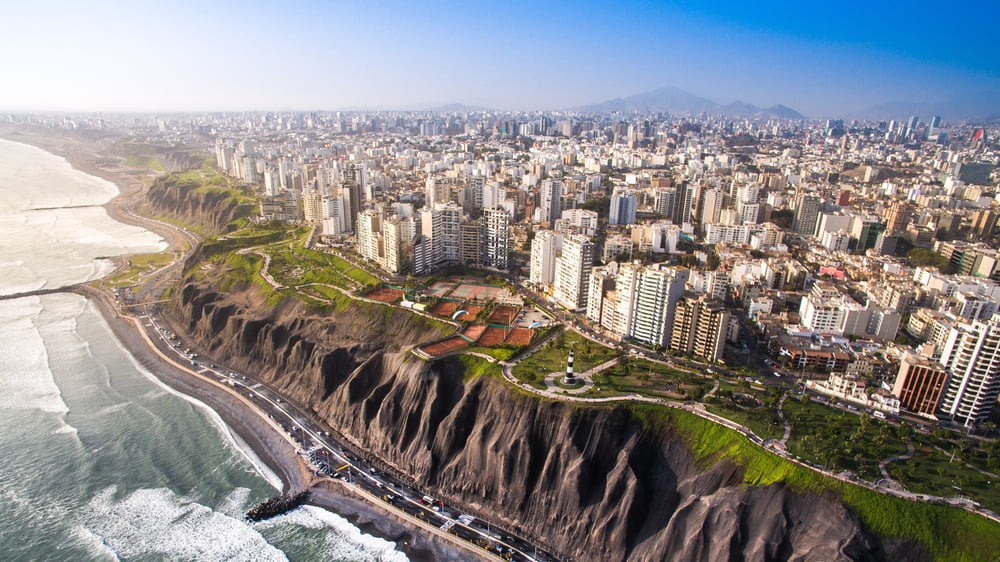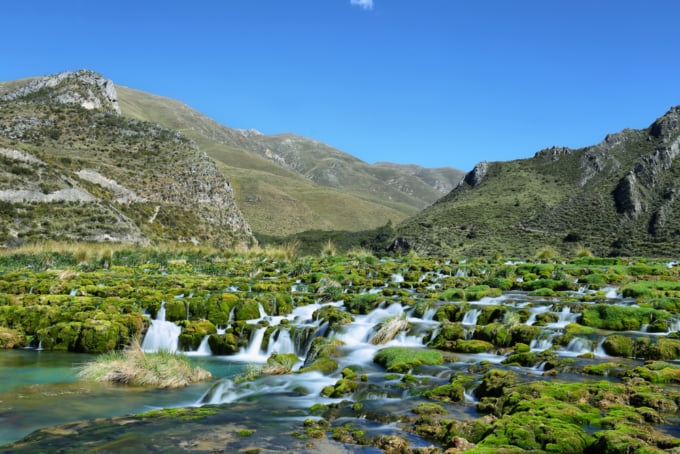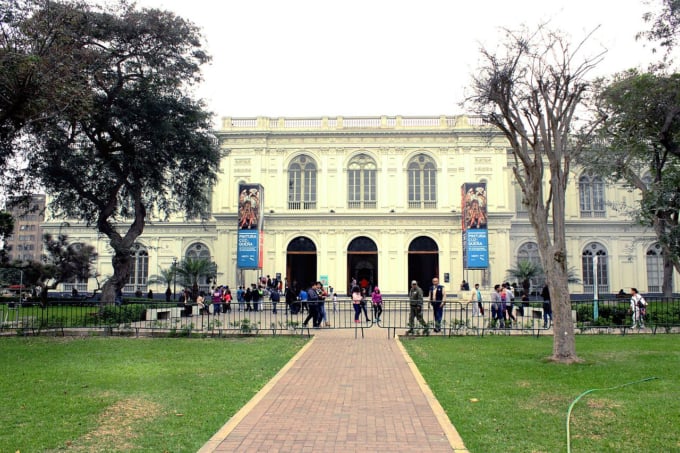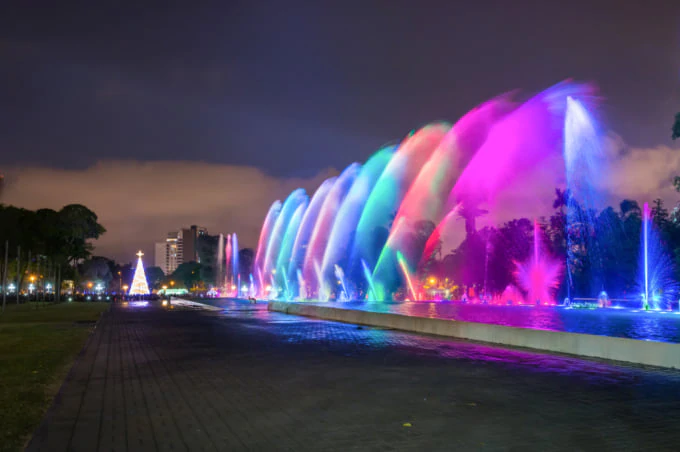
If you visit Peru, you will likely hear someone say: “It never rains in Lima”—the nation’s capital. Shivering in the chilly, damp air, you may well wonder if that is so.
LIMA is located in the great desert that runs along the Pacific Coast of South America—a region having one of the world’s most unusual climates. This arid strip of land stretches from the Sechura Desert in Peru’s far north all the way to the Atacama Desert of northern Chile.
The coastal desert lies between the rugged Andes and the azure Pacific Ocean. From a distance, there appears to be nothing along the coast but stark, rugged hills of stone and sand in every imaginable shade of beige and brown. Erosion has draped many of the hillsides with cascades of brown rocks. These gradually make their way down the slope toward the sea, occasionally nudged along by the frequent earth tremors that occur here.

Once the rocks reach the shore, the pounding waves of the Pacific slowly grind them into sand, which the wind forms into crescent-shaped dunes. In parts of this vast desert, no rain has been recorded in 20 years, making it one of the driest spots on earth. But what makes this area so dry?
The Rain Shadow of the Andes
The answer has to do with the trade winds, which blow from east to west. As they encounter the high, saw-toothed ridges of the Andes Mountains, the winds are forced upward. Ascending to pass over the Andes, the winds cool, causing the moisture they carry to condense and fall as rain and snow, mostly on the eastern side of the range. Thus, the mountains cast a rainless shadow over the western slope.
Additionally, neither the cold Peru Current, or Humboldt Current, flowing northward from Antarctica nor the wind blowing in from the South Pacific provides much moisture. All these factors combined produce an extremely dry, though not hot, desert. Oddly enough, although rain is scarce, the humidity of the air is very high, especially during the Peruvian winter, from May to November. Where does this humidity come from?
The Garúa
In wintertime a blanket of low clouds hangs over the coast, and a heavy mist, which Peruvians call garúa, rolls in from the Pacific Ocean. During this season, months may pass without a glimpse of the sun, giving the region a chilly—some say, dismal—climate. Although the area lies in the Tropics, average winter temperatures in Lima remain between about 60 and 64 degrees Fahrenheit [16° and 18°C.]. In the winter relative humidity can reach 95 percent without raining, and the well-adapted Limeños, residents of Lima, bundle up against the damp, penetrating cold.*

The light winter drizzle is enough to wet the streets of Lima and also to bring life back to dormant desert plants on the high coastal hills. Large flocks of goats, sheep, and cattle take advantage of the green pastures that result. Moreover, since the early 1990’s, some towns in the desert have been using fog collectors—large polypropylene nets on which the fog condenses—to harvest water for drinking and for watering gardens from the low, mist-laden clouds.
Still, moisture from the fog and clouds is not enough for wild vegetation to flourish year-round. Total precipitation in Lima is rarely more than two inches [50 mm] a year and comes mostly from condensation of the garúa. Therefore, the only green plants that thrive in the coastal desert are those that are irrigated by small rivers that bring life-giving water down from high in the snowcapped Andes. Viewed from the air, the little river valleys look like green ribbons lying across the desert.
Living Without Rain
To survive in such a dry climate, Peru’s ancient coastal cultures—such as the Chimu and the Mochica—built sophisticated irrigation systems. Like those of ancient Egypt, these extensive agricultural projects sustained highly organized civilizations. The ancient Peruvians built well-developed cities, including pyramid temples, large walls, and reservoirs, using adobe bricks. Because of the paucity of rain, these ruins are well preserved, giving archaeologists a good picture of pre-Columbian life in Peru. Today many coastal settlements are still dependent on restored aqueducts and canals that were first built thousands of years ago.

As the early desert inhabitants learned, the desert soil is very fertile where there is water. Peru’s modern-day coastal irrigation projects provide the needed water to cultivate a variety of crops, including cotton, rice, corn, sugarcane, grapes, olives, and asparagus as well as other vegetables and fruits. At present, more than half of Peru’s population of about 27 million live along the narrow coastal strip.
When It Does Rain
Sometimes, however, rain does fall in parts of the desert, including Lima. Every few years, the cool Peru Current gives way to warmer waters that sweep over from the western Pacific. This phenomenon, known as El Niño, signals the imminent arrival of rain. Especially strong El Niños struck in 1925, 1983, and 1997/98. Understandably, desert dwellers, who are used to getting practically no rain at all, are ill prepared for torrential downpours and the ensuing floods.
One such flood struck Ica, Peru, in 1998. The Ica River inundated large areas of the city, and the mud-brick homes just melted away. Other parts of the desert benefited, soaking up the moisture and becoming lush pastures. The latest El Niño turned much of the Sechura Desert into a garden of green sprinkled with beautiful flowers, reminding us of God’s promise that one day ‘the desert will blossom as the saffron.’ (Isaiah 35:1) The heavy rains also created a huge lake in the desert—estimated to be some 185 miles [300 km] long and 25 miles [40 km] wide—that newspapers nicknamed La Niña.
Peru’s great coastal desert certainly adds to the wide variety of natural wonders found on our planet. Although it seldom rains here, through irrigation and proper use of precious water, this arid land has become a pleasant home for millions.
[Footnote]
In the summer when temperatures climb to 70 or 80 [20 or 27°C.] degrees Fahrenheit, Lima residents shed their heavy clothes and enjoy the many fine beaches along the coast.

Wealth From Waste
For millenniums the cool, nutrient-rich seas off the west coast of Peru have provided food—largely sardines and anchovies—for millions of seabirds. Because there is little rain in the area, over the years the birds’ droppings accumulated on the coastal islands in immense piles—sometimes over 100 feet [30 m] high! Before the Spanish arrived, it was discovered that these droppings, called guano after their Quechua Indian name, were an excellent fertilizer. In the latter half of the 19th century, guano became a highly successful export product for Peru, until it was replaced in the world market by chemical fertilizers. By then, the old accumulations had been depleted. Today supplies are mostly limited to the birds’ current production.
Source
Plagiarism is the copying & pasting of others work without giving credit to the original author or artist. Plagiarized posts are considered fraud and violate the intellectual property rights of the original creator.
Fraud is discouraged by the community and may result in the account being Blacklisted.
If you believe this comment is in error, please contact us in #appeals in Discord.
Hi! I am a robot. I just upvoted you! I found similar content that readers might be interested in:
https://wol.jw.org/en/wol/d/r1/lp-e/102003367